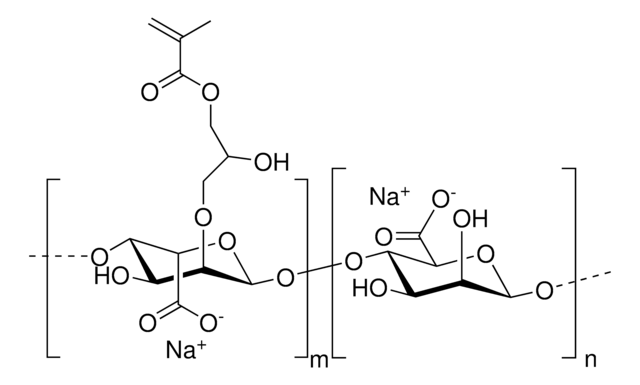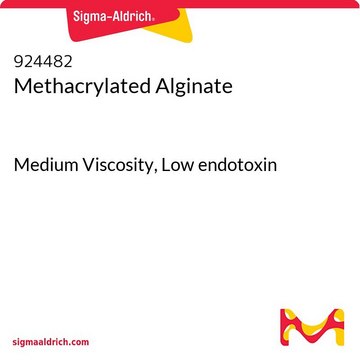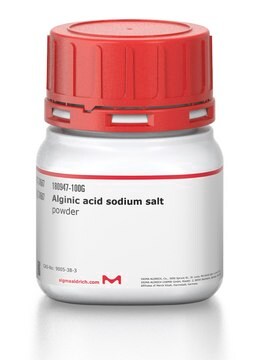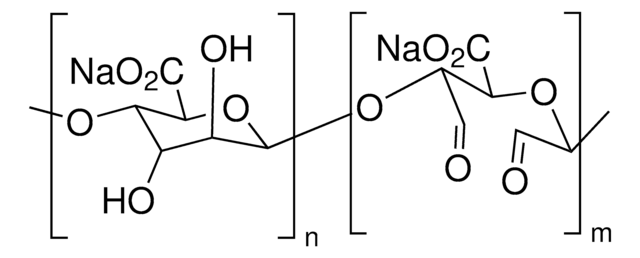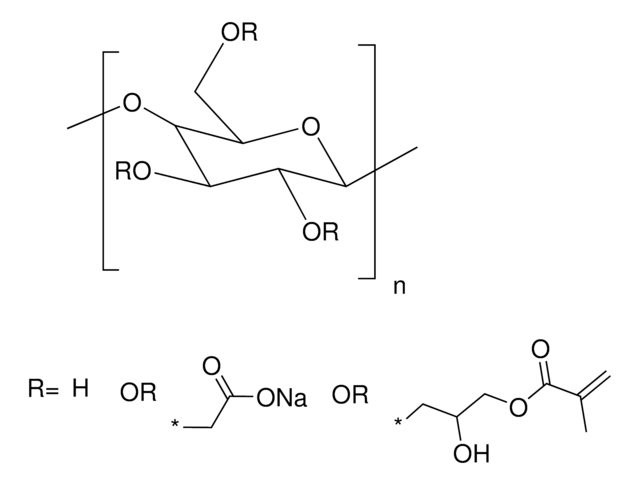추천 제품
애플리케이션
Alginate is an anionic polysaccharide that is widely used in pharmaceutical and biomedical applications due to its non-animal origin, low toxicity, biocompatibility, and biodegradability. Alginate hydrogels are commonly used to fabricate tissue engineering scaffolds, bioinks for 3D bioprinting, and nanocarriers for drug & gene delivery. While alginate is commonly crosslinked into a hydrogel via ionic-crosslinking with divalent cations (e.g., Ca2+), these gels feature limited long-term stability due to exchange reactions and migration of divalent cations from the alginate matrix. To prevent matrix degradation, alginate can be functionalized with reactive groups that can be chemically crosslinked, such as methacrylates. Methacrylate-functionalized alginate can be used to prepare hydrogels by thermal or photochemical crosslinking of the terminal methacrylates. Properties of the resulting hydrogel (e.g., stiffness, swelling ratio, rate of degradation) can be tuned by alginate molecular weight, degree of methacrylate functionalization, and crosslink density.
Storage Class Code
11 - Combustible Solids
WGK
WGK 3
Flash Point (°F)
Not applicable
Flash Point (°C)
Not applicable
가장 최신 버전 중 하나를 선택하세요:
Photocrosslinkable polysaccharides for in situ hydrogel formation
Smeds K A and Grinstaff M W
Journal of Biomedical Materials Research Part A, 54 (1), 115-112 (2001)
Siddhesh N Pawar et al.
Biomaterials, 33(11), 3279-3305 (2012-01-28)
Alginates have become an extremely important family of polysaccharides because of their utility in preparing hydrogels at mild pH and temperature conditions, suitable for sensitive biomolecules like proteins and nucleic acids, and even for living cells such as islets of
Andrew D Rouillard et al.
Tissue engineering. Part C, Methods, 17(2), 173-179 (2010-08-14)
Methods for seeding high-viability (>85%) three-dimensional (3D) alginate-chondrocyte hydrogel scaffolds are presented that employ photocrosslinking of methacrylate-modified alginate with the photoinitiator VA-086. Comparison with results from several other photoinitiators, including Irgacure 2959, highlights the role of solvent, ultraviolet exposure, and
Oju Jeon et al.
Biomaterials, 30(14), 2724-2734 (2009-02-10)
Photocrosslinked and biodegradable alginate hydrogels were engineered for biomedical applications. Photocrosslinkable alginate macromers were prepared by reacting sodium alginate and 2-aminoethyl methacrylate in the presence of 1-ethyl-3-(3-dimethylaminopropyl)-carbodiimide hydrochloride and N-hydroxysuccinimide. Methacrylated alginates were photocrosslinked using ultraviolet light with 0.05% photoinitiator.
Jia Jia et al.
Acta biomaterialia, 10(10), 4323-4331 (2014-07-08)
Recent advances in three-dimensional (3-D) printing offer an excellent opportunity to address critical challenges faced by current tissue engineering approaches. Alginate hydrogels have been used extensively as bioinks for 3-D bioprinting. However, most previous research has focused on native alginates
자사의 과학자팀은 생명 과학, 재료 과학, 화학 합성, 크로마토그래피, 분석 및 기타 많은 영역을 포함한 모든 과학 분야에 경험이 있습니다..
고객지원팀으로 연락바랍니다.